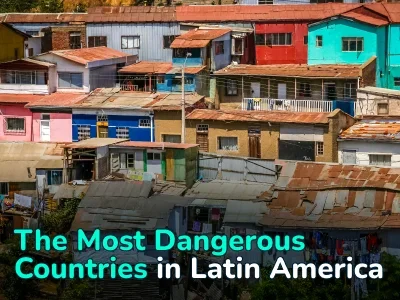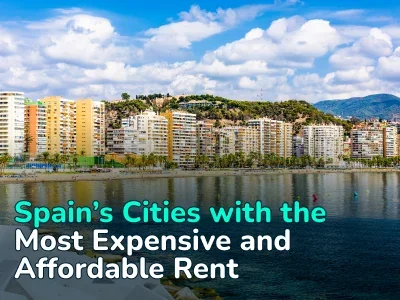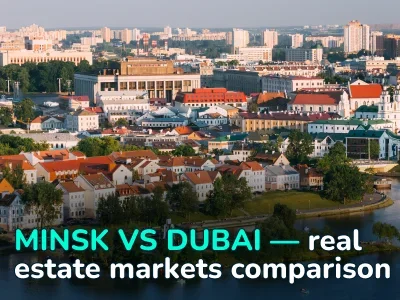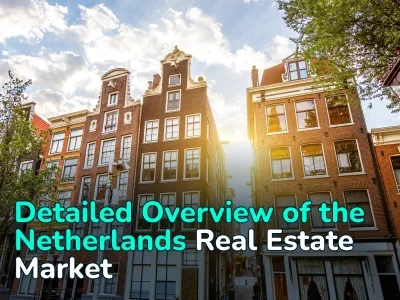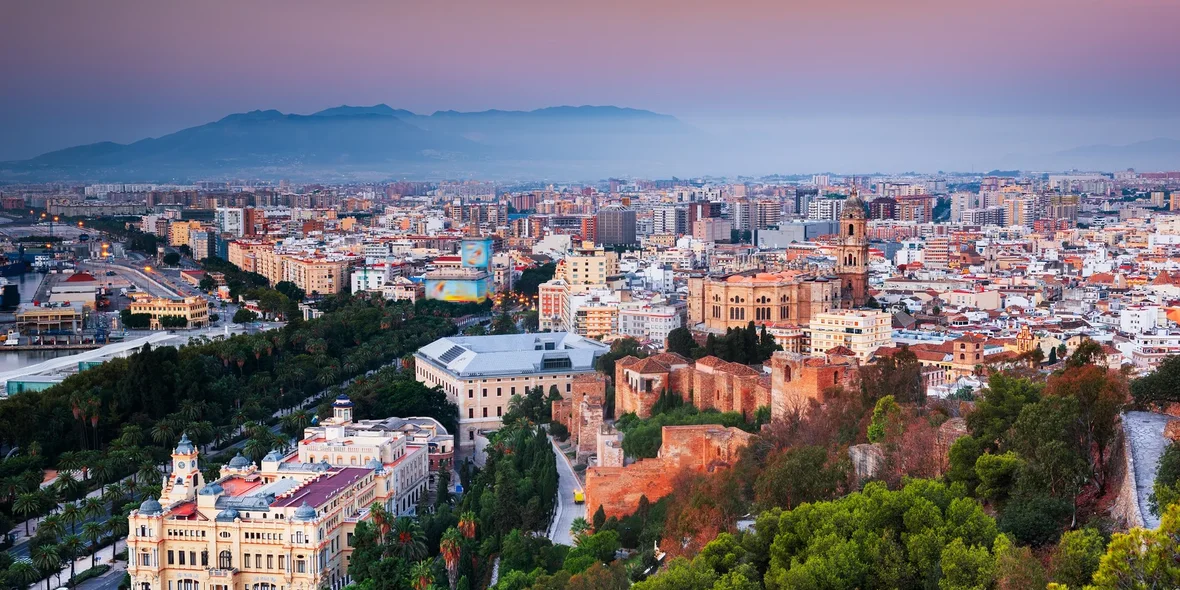
Buying an Apartment in Spain: Full Guide with Prices, Taxes, and Expert Tips for Investors
Buying an apartment in Spain ranks among the most attractive investments for foreigners. More affordable prices compared to Western and Northern Europe contribute to the fact that in 2024 alone, foreigners purchased 139,102 properties in Spain, which is nearly 20% of all transactions.
In 2025, interest in Spanish real estate is fueled by several factors. First, the market is experiencing price stabilization and even a slight decrease of current mortgage rates in Spain. This is notable considering that around 50 to 55 percent of all real estate transactions are financed through loans.
Second, some regions continue to face a housing shortage. In Spain, apartments are hard not only to buy but also to rent. The problem is especially acute in resort areas, where rental rates are rising very quickly. This situation attracts investors to rental property.
In this article, we will examine how the Spanish real estate market operates today, which regions are in the highest demand, and how much housing actually costs in different parts of the country.
Overview of the Spanish Real Estate Market
Foreign buyers remain one of the key drivers of demand for local property. In the first half/second quarter of 2025, their share accounted for 14.1% of all transactions, meaning that every seventh contract involved a foreign purchaser.
However, the rental market is overheated. According to industry portals, rental rates for apartments in most provinces of Spain are growing at double-digit rates, averaging 10–12% per year. The main problem remains the limited supply, which is further aggravated by high tourist flows. This pushes investors to buy properties for rental purposes, which in turn increases both the shortage and the prices.
Most popular regions for buying apartments in Spain:
- Andalusia. This region accounts for around 20% of all transactions in the country. The highest demand is in Málaga, where foreign buyers are responsible for about 38.4% of all deals, which is even higher than in the Balearic Islands.
- Valencia. The share of foreign buyers in this province is 28%, which is double the national average of 14.1%. The province of Alicante shows the highest demand, with 43% of transactions involving foreign buyers.
- Catalonia. Catalonia accounts for 17.3% of all transactions nationwide. The town of Sitges, near Barcelona, is especially popular among Americans: over the past five years, prices there have risen by 21%, and demand continues to grow despite prices being far from low. The average price per square meter in this area is €4,661.
- Madrid. The capital region represents 6.5% of Spain’s national real estate market. Madrid is considered the second most attractive European city for residential property investment after London.
- Island and Northern Regions. The Balearic Islands and the Canary Archipelago have long been leaders in terms of the share of foreign buyers and investment demand. This has driven prices up significantly, prompting investors to look for more affordable properties. As a result, interest has been shifting toward northern regions such as Galicia, including Asturias and Cantabria.
Advantages and Risks of Buying Property in Spain
The main advantage of Spain is its geographical location. The country has access not only to the Mediterranean Sea but also to the Atlantic Ocean, and in both cases its coastline is significantly longer than that of neighboring France. While the Italian coastline suffers from limited construction capacity, flats for sale in Spain by the sea are consistently available, partly due to the country’s large land reserve.
Other advantages of Spanish property:
- Investment appeal. Investing in apartments can provide rental yields of 4–7% per year, and in some cases up to 9.8% (for example, in Valencia). In addition, over the past eight years, the average cost of apartments in Spain has increased by 40%, and if the trend continues, it could prove to be a strong long-term investment.
- High rental demand. The country welcomes 85 million tourists annually, many of whom seek short-term rental housing. Long-term rentals are in strong demand in major cities such as Madrid.
- Mortgages for foreigners. Getting a mortgage in Spain as a foreigner is possible. However, for non-residents, the mortgage down payment requirement is significantly higher, reaching up to 40%.
Risks associated with Spanish real estate:
- Housing crisis and rising prices. Demand for property exceeds supply, driving up prices. In 2024, in 26 provinces, families were spending up to 30% of their income on mortgage payments, while in Palma (Mallorca) and Tenerife, this share reached 60–67%.
- Legal and language barriers. A lack of Spanish language skills complicates document processing and communication with notaries and lawyers. Hiring translators and legal advisers can add 1–3% to the transaction cost.
- Additional expenses. Buying a flat in Spain involves hidden costs borne by the buyer, such as the property transfer tax, VAT, and the annual property tax (IBI).
Squatters (Okupas) in Spain
Spain has a phenomenon that is unique in its own way: squatting, or “okupas,” meaning the illegal occupation of property. This is a fairly common problem, and owners of local real estate may encounter it, especially non-residents. Property squatters are individuals or groups who occupy vacant houses or flats in Spain without the owner’s permission.
Squatters are not a single organized group but rather any individuals who settle in someone else’s property in Spain. They are most often classified into the following categories:
- Marginalized groups: people seeking free housing due to financial hardship.
- Organized movements: activists advocating for the right to housing in cities facing a housing crisis.
- Opportunists: individuals using vacant properties for temporary living or for subletting.
Spanish law protects the rights of occupants, even if they are illegal. If a squatter manages to stay in a property for more than 48 hours, they can only be evicted by a court decision, and the legal process can take from 6 to 18 months.
Squatting is a risk for property owners if:
- The property is purchased not for permanent residence, such as for seasonal vacations or investment purposes. In Barcelona, 60% of squatting cases involve vacant apartments and houses.
- The property is located in a disadvantaged neighborhood, with higher risks in the suburbs of large cities.
- The properties were purchased at auctions or directly from banks. Information about such properties is publicly available, including the exact address. While the bank still owns them, there are no issues; however, there is a brief period during which they are considered vacant, and squatters may move in. This usually occurs after the property has been sold but before the transfer of ownership to the new buyer has been fully completed.
To protect against okupas, it is usually enough to install a security alarm system and strong locks. In extreme cases, one can purchase squatting home insurance in Spain or sign a rental agreement so that the property is not considered vacant. If squatters break into your property, you should contact the police, as self-eviction is illegal and can result in fines.
Property Prices in Spain in 2025
In the first quarter of 2025, the average price per square meter of housing reached €2237—2411, which is 11.16% higher than in 2024. Prices vary by region, so apartments in Spain located by the sea are more expensive than those inland. The highest prices are recorded in large cities (Madrid, Barcelona) and tourist areas (Costa del Sol, Balearic Islands), while inland provinces remain relatively affordable.
Average apartment prices in Spain:
|
Region |
Average price, €/m² |
Approximate total price, € (80 m²) |
|
Andalusia |
2539 |
203,120 |
|
Aragon |
1502 |
120,160 |
|
Asturias |
1586 |
126,880 |
|
Balearic Islands |
5025 |
402,000 |
|
Canary Islands |
3090 |
247,200 |
|
Cantabria |
1929 |
154,320 |
|
Castile and León |
1233 |
98,640 |
|
Castile-La Mancha |
982 |
78,560 |
|
Catalonia |
2632 |
210,560 |
|
Valencian Community |
2271 |
181,680 |
|
Extremadura |
979 |
78,320 |
|
Galicia |
1452 |
116,160 |
|
La Rioja |
1379 |
110,320 |
|
Madrid (Community) |
4359 |
348,720 |
|
Murcia (Region) |
1505 |
120,400 |
|
Navarre |
1764 |
141,120 |
|
Basque Country (Euskadi) |
3263 |
261,040 |
At present, the highest demand for apartments in Spain is recorded in major cities such as Madrid and Barcelona and their surrounding suburbs. The housing shortage is driving investors to acquire even abandoned developments in towns like Sesena and Valdeluz. However, the strongest demand remains for seaside properties — particularly in Costa del Sol, Valencia, and Alicante — while in the luxury segment, the Balearic Islands and Malaga lead the market.
Average property sale prices in Spain:
|
Region |
Average price, €/m² |
|
Madrid |
4290 |
|
Catalonia (Barcelona) |
3995 |
|
Valencia |
2358 |
|
Alicante (Costa Blanca) |
2100–2264 |
|
Andalusia (Marbella) |
4200–6500 |
|
Murcia |
1369 |
|
Extremadura |
950 |
The Balearic Islands (Mallorca, Ibiza, Menorca) and the Canary Islands (Tenerife, Gran Canaria, Lanzarote) remain among the most expensive and sought-after regions in Spain. Prices here are growing faster than the national average, at a rate of 12–18% per year.
Average apartment price in Spain:
|
Island/Region |
Average price, €/m² |
Annual change, % |
|
Balearic Islands |
4500–4707 |
+12.0 |
|
Canary Islands |
2800–3000 |
+16.3–17.8 |
The difference between the primary and secondary markets is not very pronounced. Buying an apartment in Spain from a developer costs only 10–15% more than a secondary property in good condition, which is why the secondary market accounts for 91% of all transactions.
Step-by-Step Process for Buying an Apartment in Spain
You can search for apartments for sale in Spain on your own through websites of international or local companies and aggregators, as well as via a real estate agent. Once you have found a suitable property, you must obtain an NIE (Número de Identidad de Extranjero), which is a foreigner’s identification number. It is required for any financial transaction in Spain, including the purchase of real estate.
You can obtain an NIE at the Spanish consulate in your country or at the immigration office (Oficina de Extranjería) after arrival in Spain. To apply, you will need:
- Passport.
- 3×4 cm photo.
- Completed EX-15 form.
- Proof of income.
- Reason for request (for example, property purchase).
The next step is to open a bank account in Spain. This account will be used to pay for the property and utility services. Be sure to confirm in advance whether international transfers are allowed for this account and, if so, the commission charged. Required documents include:
- Passport.
- NIE.
- Proof of income (employment certificate, bank statement).
- Residential address (can be temporary, such as a hotel).
Before making the purchase, it is necessary to check the legal status of the chosen property. This can be done through the local Property Registry (Registro de la Propiedad). Requesting a Nota Simple extract will show who holds ownership rights to the property and whether there are any debts, liens, mortgages, or unpaid utility bills. If you are working through a real estate agency in Spain, the agency’s specialist usually handles this verification.
Once the property is selected, both parties sign a preliminary contract. This document sets out the terms of the deal, the price, and the timeline. Typically, the buyer pays a deposit equal to 10% of the property’s value. If the deal falls through due to the buyer’s fault, the deposit is forfeited to the seller as compensation; however, if the seller cancels the deal, the deposit is returned to the buyer in double.
The main contract (Escritura Pública) is signed before a notary in the presence of all parties. If you plan to get a mortgage for property in Spain, it must be finalized before this stage, as a bank representative must be present at the signing. The notary reads the contract terms aloud, after which the buyer pays the remaining amount, and the parties sign the act of key handover.
After signing the contract, ownership rights are registered in the Property Registry (Registro de la Propiedad). Following the purchase, you must:
- Transfer utility contracts (water, electricity, gas) to your name.
- Pay the annual property tax.
- Submit a purchase declaration to the tax office.
- If you plan to rent out the apartment, you must obtain a rental license (costing €100—300, depending on the region).
Taxes and Additional Costs
Taxes for non-residents in Spain apply only to income generated within the country, while residents are taxed on worldwide income. A person becomes a tax resident if they have lived in Spain for more than 183 days in a year or if their main economic interests are in Spain (for example, primary employment, business, or asset management).
The main focus here is on property taxes in Spain, whether for purchase, sale, or rental. These are felt most strongly at the time of purchase, as they can increase total expenses by 10–15%. In 2023, about 10% of transactions involving foreigners required additional payments due to underestimating the impact of taxes.
Taxes on Spanish property purchase:
|
Tax |
Property type |
Rate |
Notes |
|
ITP (Impuesto sobre Transmisiones Patrimoniales) |
Resale property |
6–13% (depends on region) |
Andalusia: 7%; Valencia: 10–11%; Canary Islands: 5–6.5% |
|
IVA (Impuesto sobre el Valor Añadido) |
New builds |
10% (residential), 21% (commercial, land plots) |
On the Canary Islands, IGIC applies instead, at 5% |
|
AJD (Actos Jurídicos Documentados) |
New builds, mortgages |
0.5–1.5% |
Depends on region; Andalusia: 1.2%; Valencia: ~1.5%; Canary Islands: 0.75–1.0% |
ITP is the property transfer tax for resale homes and is the main purchase tax for second-hand housing in Spain. Buyers must pay it within 30 days of the transaction; otherwise, the ownership cannot be registered.
Taxes on property ownership in Spain:
|
Tax |
Rate |
Notes |
|
IBI (Impuesto sobre Bienes Inmuebles) |
0.4–1.3% of cadastral value |
Varies by region; Barcelona: 0.66–0.8% |
|
IRNR (Impuesto sobre la Renta de No Residentes) |
1.1% of cadastral value if assessed in the last 10 years; 2% if older |
24% tax on rental income for non-EU residents; 19% for EU residents |
|
Wealth Tax (Impuesto sobre el Patrimonio) |
0.24% to 3.03%, depending on autonomous community |
€300,000 of primary residence value is exempt |
|
Municipal garbage collection fee |
~€80/year on average |
Madrid: ~€141; ranges from €30 to €185 depending on municipality |
IBI property tax in Spain is an annual municipal tax on property ownership paid by both residents and non-residents. IRNR is a special tax for non-resident property owners in Spain; it must be paid even if the property is not rented out.
The wealth tax applies to all assets in Spain, including:
- Real estate (at market, not cadastral, value)
- Bank accounts
- Shares, bonds, and other investments
- Expensive vehicles, yachts, etc.
A tax exemption applies to a primary residence. For example, if a villa is worth €500,000, €300,000 is exempt, and only the remaining €200,000 is taxable. If the total value of all assets in Spain is below €700,000, the wealth tax is not due.
The main tax is the capital gains tax in Spain on property. For residents, it is calculated progressively based on the profit:
- Up to €6000 — 19%
- €6000—50,000 — 21%
- €50,000—200,000 — 23%
- €200,000—300,000 — 27%
- Above €300,000 — 30%
Non-resident sellers from the EU pay a flat 19%, while those from third countries pay 24%. To ensure payment, the buyer is required to withhold 3% of the purchase price and transfer it to the tax authorities immediately after the transaction.
If the purchase price from a non-resident seller is €300,000, the buyer withholds 3%, or €9000, and pays it to the tax office via form Modelo 211 within one month of the transaction. The remaining €291,000 is transferred to the seller.
The seller must then file form Modelo 210 within four months of the sale. If the actual tax owed is higher than the 3% withheld, the seller must pay the difference. If it is lower or if there is no gain, they can request a refund.
In addition to CGT real estate tax in Spain, sellers must pay the Municipal Land Value Increase Tax (Plusvalía Municipal), which applies only to the increase in the value of the land. There are two calculation methods, pay 30% of the capital gain from the land sale or apply a coefficient to the cadastral value of the land:
- 1 year — 0.14.
- 5 years — 0.12.
- 10 years — 0.10.
- 20 years — 0.08.
Mortgages for Foreigners
Mortgage in Spain for foreigners is a common option when purchasing property. In 2024 alone, around 30% of all transactions involving foreigners were completed using financing.
Key requirements include:
- Proof of income. Income certificates, bank statements for the last 6–12 months, or tax returns are required. Minimum income requirements vary by bank but are often in the range of €2500—€3500 per month.
- Credit history. Banks request data from international credit bureaus.
- Down payment. For non-residents, this usually amounts to 30–40% of the property’s appraised value, while for residents it is 10–20%.
- Foreigner Identification Number (NIE). Required to open a bank account and apply for a mortgage.
- Age. The maximum age at the end of the mortgage term must not exceed 70–75 years.
- Insurance. Property insurance is mandatory to obtain a mortgage in Spain, and some banks also require life insurance for the borrower.
Types of mortgage interest rates in Spain:
|
Mortgage type |
Rate |
Term |
|
Fixed |
2.45–2.8% |
up to 30 years |
|
Variable |
2.6–3.1% (Euríbor + 0.5–1.0%) |
up to 30 years, typically 15–25 |
|
Mixed |
Fixed for the first 3–5 years (1.75–2.5%), then Euríbor + ~0.6–0.8% |
15–25 years (up to 30 possible) |
The maximum loan amount is 60–70% of the appraised value of the property, which is generally 20–50% lower than its market value. Early repayment is possible, with a commission of 0.25–0.5% in the first 3–5 years. As an alternative to getting a mortgage in Spain, developers in Spain offer installment payment plans for new builds. The buyer pays an initial deposit, with the balance paid over 1–5 years.
Frequently Asked Questions About Buying an Apartment in Spain
Is it possible to get a mortgage in Spain as a non-resident?
Non-residents can obtain a mortgage in Spain, but the process and conditions are stricter compared to those available to residents:
- Non-residents can typically borrow 60–70% of the property’s appraised value (LTV, loan-to-value). In rare cases, such as when purchasing bank-repossessed properties, financing of up to 100% may be possible, but under more stringent conditions. For comparison, residents can obtain up to 80–90%.
- Spanish mortgage rates for non-residents are higher than for residents, but usually within 1–2% above.
- The maximum term for non-residents is generally 20–25 years, occasionally up to 30, whereas residents can secure mortgages for up to 40 years.
- Banks require proof of stable income and a debt-to-income ratio not exceeding 30–35% of monthly income.
- Non-residents must provide a deposit of 30–40% of the property’s value, plus an additional 10–13% for extra costs (taxes, notary fees, valuation).
Mortgage in Spain for EU citizens is easier to get due to unification processes in Europe. Applicants from third countries are subject to more thorough checks, which can delay the approval process.
Does buying an apartment in Spain grant residency?
Buying property, including a Spanish mortgage for foreigners no longer grants the right to residency. As of April 2025, Spain has officially abolished its residency-by-investment program. Under the previous scheme, a minimum investment of €500,000 in the country’s economy, including real estate purchases, was required.
What property tax in Spain exists for foreigners?
There are several taxes on property in Spain that are related to both residents and non residents. When buying a resale property, you must pay the Property Transfer Tax (ITP), which ranges from 6% to 13% of the property value. New apartments for sale in Spain are subject to VAT (IVA) at a rate of 10%. The annual property tax (IBI) is calculated based on the cadastral value, at rates from 0.4% to 1.1% (up to 1.3% in some cities).
Is property insurance in Spain obligatory?
In Spain, property insurance is not mandatory. However, if you take out a mortgage from a bank, the bank will require you to insure the apartment insurance in Spain and, in some cases, also the borrower’s life.
Banks typically require a policy that covers at least damage from fire, flooding, and other natural disasters. This usually includes both structural and contents insurance. The cost of house insurance in Spain ranges from €150 to €500 per year, depending on the size of the property and the region.
If you plan to rent out the apartment, insurance is highly recommended. A policy can cover tenant-related damage, theft, or liability to third parties (for example, neighbors in case of water leakage).
What are the main Spanish house insurance companies?
Spain has many insurance companies offering home insurance (seguros de hogar), including both local and international brands. Below are the largest players in the Spanish property insurance market:
- Mapfre. The largest insurance company in Spain. Suitable for both property owners and tenants, it offers legal assistance and 24/7 customer support.
- Caser Seguros. A popular insurer with a focus on expats. Comprehensive coverage includes all-risk protection and appliance replacement. Easy online application process.
- Liberty Seguros. An international company specializing in expat homes insurance in Spain, especially in tourist regions.
- AXA Spain. A global insurer with a strong presence in Spain. Offers English-speaking support and the option to insure valuable items.
Author
I write informative articles about real estate, investments, job opportunities, taxes, etc.











